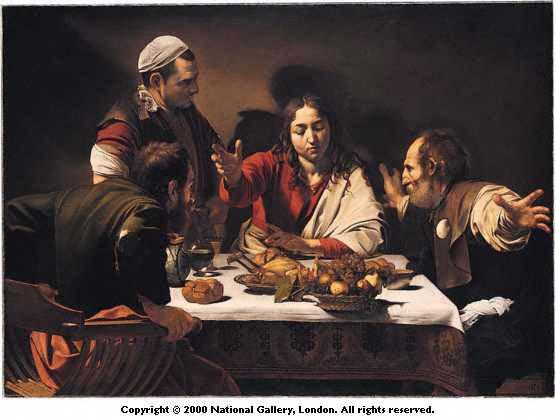Caravaggio Gallery
Oil and egg tempera on canvas 141 x 196.2 cm.
Two of Jesus' disciples were walking to Emmaus after the Crucifixion when the resurrected Jesus himself drew near and went with them, but they did not recognise him. At supper that evening in Emmaus '... he took bread, and blessed it, and brake and gave to them. And their eyes were opened, and they knew him; and he vanished out of their sight' (Luke 24: 30-31). Christ is shown at the moment of blessing the bread and revealing his true identity to the two disciples.
Caravaggio's innovative treatment of the subject makes this one of his most powerful works. The depiction of Christ is unusual in that he is beardless and great emphasis is given to the still life on the table. The intensity of the emotions of Christ's disciples is conveyed by their gestures and expression. The viewer too is made to feel a participant in the event.
The picture was commissioned by the Roman nobleman Ciriaco Mattei in 1601. Caravaggio painted a second more subdued version of the Supper at Emmaus about five years after the Gallery's work.
http://digitalconsciousness.net/top sites/?iy=285

viewer |
|
|
| Lute-Player |
Supper at Emmaus |
| David with the Head of Goliath |
| Madonna of the Rosary |
| Death of the Virgin |
| Musicians |
| Sacrifice of Isaac |
Biography
Bulletin Board
Renowned Art
(home)
Caravaggio is also known as Michelangelo Merisi and as the second Michelangelo. Caravaggio painted mostly devotional art, he focused on figures and events from the New Testament and took seriously the mundane yet monumental quality of Christianity. He used Roman street people as the model for the Apostles and Mary. He used larger than life proportions, highly theatrical lighting and crowded his significant figures into shallow spaces.
all artists, with thumbnails: by birth year | alphabetically
all artists: by birth year | alphabetically
artists born in the 13th 14th 15th 16th 17th 18th 19th 20th century